Text
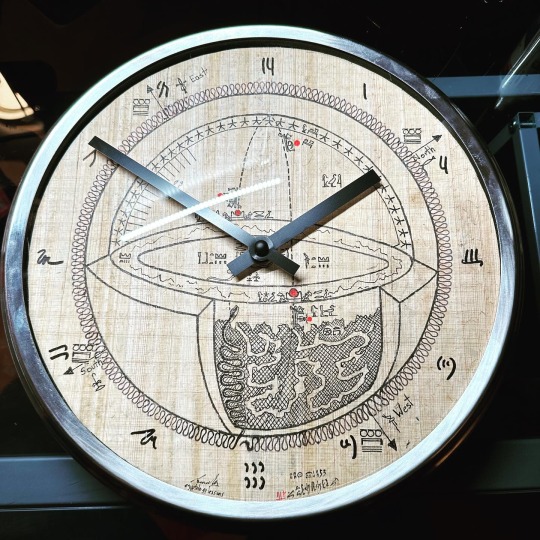

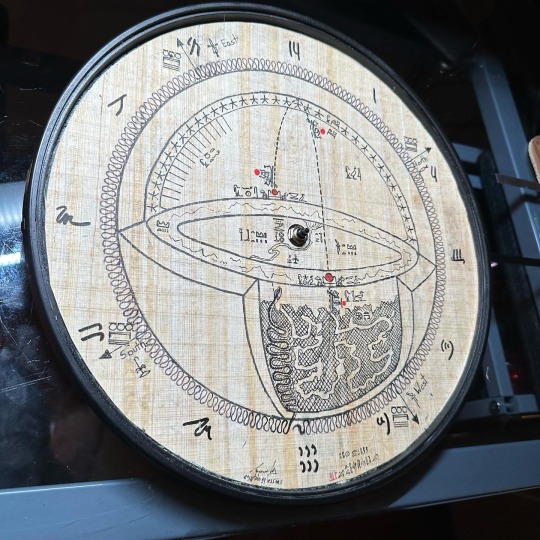





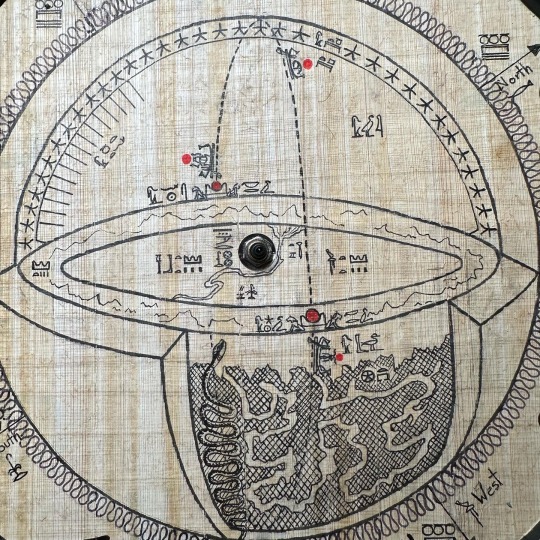

A modern recreation of the Ancient Egyptian cosmological world. The video provides details and explanation of the art, which is greated on natural papyrus paper.
Dimensions: Diameter 12”, Depth of Clock 2”
The original concept art derived from Egyptologist @Tito Vivas (Gracias/Thank you)
Photo of Tito shared by Egyptologist @elianubis (Gracias/Thank you)
𓋹𓎬𓋹𓎬𓋹𓎬𓋹𓎬𓋹𓎬𓋹𓎬𓋹𓎬𓋹𓎬𓋹𓎬𓋹𓎬𓋹𓎬𓋹𓎬𓋹𓎬𓋹𓎬𓋹𓎬𓋹
🎥 @egyptologylessons 𓋹𓊽𓋴𓆖���𓇳𓎛 ©️ 𓊁𓊁𓊁𓊁𓊁𓊁𓊁𓊁𓊁𓊁𓊁𓊁𓊁𓊁𓊁𓊁𓊁
#Ancientegypt #ägypten #egyptology #egypte #egitto #egipto #이집트 #egypt #egyptologylessons #cosmology #mythology #hieroglyphs #hieratic #clock #egypte
#ancientegypt#egyptology#egypte#hieroglyphics#egyptologist#hieroglyphs#clock#cosmology#Ancient Egyptian#Ancient Egypt
24 notes
·
View notes
Photo

A stunning photo by @egypteverafter (thank you) of the Nile River with feluccas sailing and the wondrous pyramids in the background. Photo taken from Saqqara, at the Mastaba of Nikauisesi 𓋹𓎬𓋹𓎬𓋹𓎬𓋹𓎬𓋹𓎬𓋹𓎬𓋹𓎬𓋹𓎬𓋹𓎬𓋹𓎬𓋹𓎬𓋹𓎬𓋹𓎬𓋹𓎬 @egyptologylessons 𓋹𓊽𓋴𓆖𓎛𓇳𓎛 © 𓊁𓊁𓊁𓊁𓊁𓊁𓊁𓊁𓊁𓊁𓊁𓊁𓊁𓊁𓊁 ##Ancientegypt #ägypten #egyptology #egypte #egitto #埃及 #مصر #egipto #이집트 #ancientegyptian #ancientegypt #thenile #falucca #pyramids #gizaplateau (at Saqqara) https://www.instagram.com/p/CqVxps7O-Ua/?igshid=NGJjMDIxMWI=
#ancientegypt#ägypten#egyptology#egypte#egitto#埃及#مصر#egipto#이집트#ancientegyptian#thenile#falucca#pyramids#gizaplateau
24 notes
·
View notes
Photo
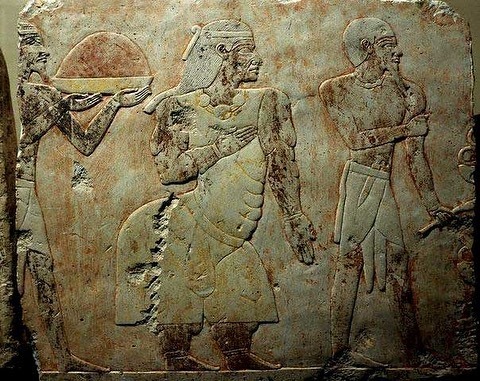
The Queen and King of Punt 𓊪𓃹𓈖𓏏𓈉 “pwnt” The land of Punt was an ancient kingdom known from Ancient Egyptian 𓂋𓐝𓎀𓀂𓀭𓏪 “rmṯ” trade records. It produced and exported gold, aromatic resins, blackwood, ebony, ivory 𓍋𓃀𓅱𓌟 “3bw” and wild animals. It is possible that it corresponds to Opone in Somalia. According to the temple 𓉞𓏏𓉐 “ḥw.t” reliefs, the Land of Punt was ruled at that time by King Parahu and Queen Ati. This well illustrated expedition of Hatshepsut (𓇋𓏠𓈖𓎸𓏏𓄂𓏏𓀼𓏪) “imn-ẖnmt ḥA.t-šps.wt” ‘United with Amun, Foremost of Nobel Ladies’ occurred in Year 9 𓆳𓊪𓏏𓏤𓎆𓐂 “rnp.t 9” of the female pharaoh's reign. 𓋹𓎬𓋹𓎬𓋹𓎬𓋹𓎬𓋹𓎬𓋹𓎬𓋹𓎬𓋹𓎬𓋹𓎬𓋹𓎬𓋹𓎬𓋹𓎬𓋹𓎬𓋹𓎬𓋹𓎬𓋹𓎬 @egyptologylessons 𓋹𓊽𓋴𓆖𓎛𓇳𓎛 © 𓊁𓊁𓊁𓊁𓊁𓊁𓊁𓊁𓊁𓊁𓊁𓊁𓊁𓊁𓊁𓊁𓊁 #Ancientegypt #ägypten #egyptology #egypte #egitto #埃及 #مصر #egipto #이집트 #punt #queen #king #hatshpesut #journey #voyage https://www.instagram.com/p/Cp-dfDtu31s/?igshid=NGJjMDIxMWI=
#ancientegypt#ägypten#egyptology#egypte#egitto#埃及#مصر#egipto#이집트#punt#queen#king#hatshpesut#journey#voyage
27 notes
·
View notes
Photo

The Four Sons of Horus from the Tomb of the Pharaoh Ay The images 𓏏𓅱𓏏𓀾𓏪 “twt.w” of the sons are usually depicted in their individual anthropomorphic forms, but in other rare circumstances they are shown in human form. They are all sitting 𓈞𓊃𓀉 “ẖs” on thrones 𓊨𓏏𓉗 “3s.t” and brandishing flail sceptres 𓈖𓐍𓐍𓌅 “nḫ3ḫ3” of kingship. In the center there is an offering table with divine food offering for the gods 𓊹𓊹𓊹 “nṯr.w” Right side: these two figures are wearing the red crown of Lower Egypt/North 𓇾𓇊 “t3-mḥw” and brandishing the flail of kingship. The Ape-headed Hapy 𓐑𓊪𓇌𓀭 The Human-headed Imsety 𓐝𓊃𓍘𓇋𓀭 Left side: these two figures are wearing the white crown of Upper Egypt/Southern 𓇾𓇙 “t3-šmˁ” and brandishing the flail of kingship. The Jackal-headed Duamutef 𓇼𓏏𓅐𓆑𓀭 The Falcon-head Quebesenuef 𓏁𓌢𓏫𓆑𓀭 Center Hieroglyphs: 𓂋𓐍𓏜𓂋𓈖𓏫𓇷𓏏𓊹𓊹𓊹𓀭𓏪 “rḫ rn.w psḏ.t” ‘Knowing the names of the gods of the Ennead’ 📸 kairoinfo4u - Flickr 𓋹𓎬𓋹𓎬𓋹𓎬𓋹𓎬𓋹𓎬𓋹𓎬𓋹𓎬𓋹𓎬𓋹𓎬𓋹𓎬𓋹𓎬𓋹𓎬𓋹𓎬𓋹𓎬𓋹𓎬𓋹𓎬 @egyptologylessons 𓋹𓊽𓋴𓆖𓎛𓇳𓎛 © 𓊁𓊁𓊁𓊁𓊁𓊁𓊁𓊁𓊁𓊁𓊁𓊁𓊁𓊁𓊁𓊁𓊁 #Ancientegypt #ägypten #egyptology #egypte #egitto #egipto #이집트 #pharaoh #tomb #ay #sonsofhorus #tombart #hieroglyphs https://www.instagram.com/p/Cp8LoPAOuRa/?igshid=NGJjMDIxMWI=
#ancientegypt#ägypten#egyptology#egypte#egitto#egipto#이집트#pharaoh#tomb#ay#sonsofhorus#tombart#hieroglyphs
39 notes
·
View notes
Photo
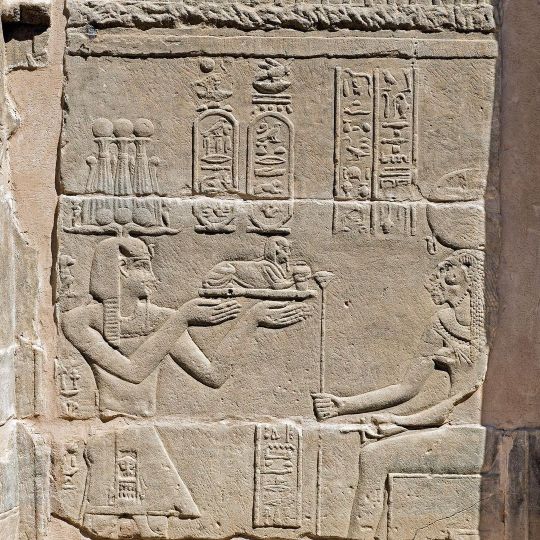
The Roman Emperor Tiberius as Pharaoh 🔸The images 𓏏𓅱𓏏𓀾𓏪 “twt.w” are from the temple of Kom Ombo/Nubt 𓋞𓃀𓇌𓏏𓊖 “nwbyt” which is dedicated to the crocodile god Sobek 𓋴𓃀𓎡𓆋 “sbk”, in Egypt 𓆎𓅓𓏏𓊖 “kmt”. 🔸Tiberius (𓍘𓃀𓇌𓂋𓊃) “tibrys” who was the second Emperor of Rome, and his images were carved on the temple 𓉞𓏏𓉐 “ḥw.t”, since Rome had conquered Egypt by this time, and turned it into a Roman province. 🔸Tiberius is giving offerings to several different gods : 1. 📸 Giving an image of himself as a sphinx and offering an oil vessels to the Goddess Tefnut 𓏏𓆑𓏌𓏏𓁴 “tfnwt” 2. 📸 giving the image of a seated Horus to the Goddess Neith 𓈖𓏏𓋋𓁐 “n.t” 3. 📸 i) top left: giving incense to the god Khenum, ii) bottom, right: the god if the Nile - Hapi 𓎛𓂝𓊪𓏭𓈘𓈗𓀭 “ḥˁpy” 4. 📸 giving the Hieroglyphs combination of “many millions of years” to the god Amun-Ra 𓇋𓏠𓈖𓇳𓏤 “ı͗mn-rˁ” 5. 📸 giving, possible, food offering to Horus 𓅄 “���r” 6. 📸 Horus and Thoth anointing Tiberius with libation, to certify his divinity and kingship 7. 📸 giving offerings of oil to the goddess Aset 𓊨𓏏𓆇 “3s.t”. 📸 kairoinfo4u - Flickr 𓋹𓎬𓋹𓎬𓋹𓎬𓋹𓎬𓋹𓎬𓋹𓎬𓋹𓎬𓋹𓎬𓋹𓎬𓋹𓎬𓋹𓎬𓋹𓎬𓋹𓎬𓋹𓎬 @egyptologylessons 𓋹𓊽𓋴𓆖𓎛𓇳𓎛 © 𓊁𓊁𓊁𓊁𓊁𓊁𓊁𓊁𓊁𓊁𓊁𓊁𓊁𓊁𓊁 #Ancientegypt #ägypten #egyptology #egypte #egitto #埃及 #مصر #egipto #이집트 #emperor #pharaoh #tiberius #komombo #temple #horus #amunra #tefnut #neith #thoth #hieroglyphs https://www.instagram.com/p/Cp23nFDOAKw/?igshid=NGJjMDIxMWI=
#ancientegypt#ägypten#egyptology#egypte#egitto#埃及#مصر#egipto#이집트#emperor#pharaoh#tiberius#komombo#temple#horus#amunra#tefnut#neith#thoth#hieroglyphs
16 notes
·
View notes
Photo

The Roman Emperor Tiberius as Pharaoh 🔸The images 𓏏𓅱𓏏𓀾𓏪 “twt.w” are from the temple of Kom Ombo/Nubt 𓋞𓃀𓇌𓏏𓊖 “nwbyt” which is dedicated to the crocodile god Sobek 𓋴𓃀𓎡𓆋 “sbk”, in Egypt 𓆎𓅓𓏏𓊖 “kmt”. 🔸Tiberius (𓍘𓃀𓇌𓂋𓊃) “tibrys” who was the second Emperor of Rome, and his images were carved on the temple 𓉞𓏏𓉐 “ḥw.t”, since Rome had conquered Egypt by this time, and turned it into a Roman province. 🔸Tiberius is giving offerings to several different gods : 1. 📸 Giving an image of himself as a sphinx to the Goddess Tefnut 𓏏𓆑𓏌𓏏𓁴 “tfnwt”. 2. 📸 giving the image of a seated Horus to the Goddess Neith 𓈖𓏏𓋋𓁐 “n.t”. 3. 📸 i) top left: giving incense to the god Khenum, ii) bottom, right: the god if the Nile - Hapi 𓎛𓂝𓊪𓏭𓈘𓈗𓀭 “ḥˁpy”. 4. 📸 giving the Hieroglyphs combination of “many millions of years” to the god Amun-Ra 𓇋𓏠𓈖𓇳𓏤 “ı͗mn-rˁ”. 5. 📸 giving, possible, food offering to Horus 𓅄 “ḥr” 6. 📸 Horus and Thoth anointing Tiberius with libation, to certify his divinity and kingship. 7. 📸 giving offerings of oil to the goddess Aset 𓊨𓏏𓆇 “3s.t”. 📸 kairoinfo4u - Flickr 𓋹𓎬𓋹𓎬𓋹𓎬𓋹𓎬𓋹𓎬𓋹𓎬𓋹𓎬𓋹𓎬𓋹𓎬𓋹𓎬𓋹𓎬𓋹𓎬𓋹𓎬𓋹𓎬𓋹𓎬𓋹𓎬 @egyptologylessons 𓋹𓊽𓋴𓆖𓎛𓇳𓎛 © 𓊁𓊁𓊁𓊁𓊁𓊁𓊁𓊁𓊁𓊁𓊁𓊁𓊁𓊁𓊁𓊁𓊁 #Ancientegypt #ägypten #egyptology #egypte #egitto #埃及 #مصر #egipto #이집트 #emperor #pharaoh #tiberius #komombo #temple #horus #amunra #tefnut #neith #thoth #hieroglyphs https://www.instagram.com/p/Cp22Axwu14s/?igshid=NGJjMDIxMWI=
#ancientegypt#ägypten#egyptology#egypte#egitto#埃及#مصر#egipto#이집트#emperor#pharaoh#tiberius#komombo#temple#horus#amunra#tefnut#neith#thoth#hieroglyphs
22 notes
·
View notes
Photo

Guilded Wood Ushabtis of Tutankhamun These royal ushabtis 𓆷𓄿𓍯𓃀𓏏𓏭𓀾 “šwbty” in the photo are only two of several other statuettes used to serve the pharaoh 𓉐𓉼 “pr-ˁ3” ‘Great House’ in the afterlife. What is of particular interesting is that they each wears the royal crown of a designated region of kingship. The left wears the white crown 𓌉𓏏𓋑 “ḥḏ.t” of Upper Egypt/Southern 𓇾𓇙 “t3-šmˁ” and the right wears the red crown 𓇋𓈖𓇋𓋔 “ini” of Lower Egypt/North 𓇾𓇊 “t3-mḥw”. Both statues are meant to brandish the sceptres of kingship - the crook 𓂝𓅱𓏏𓋾 “ˁw.t” and flail 𓈖𓐍𓐍𓌅 “nḫ3ḫ3” (the left statuette is mushing a flail). 𓋹𓎬𓋹𓎬𓋹𓎬𓋹𓎬𓋹𓎬𓋹𓎬𓋹𓎬𓋹𓎬𓋹𓎬𓋹𓎬𓋹𓎬𓋹𓎬𓋹𓎬𓋹𓎬𓋹𓎬𓋹𓎬 @egyptologylessons 𓋹𓊽𓋴𓆖𓎛𓇳𓎛 © 𓊁𓊁𓊁𓊁𓊁𓊁𓊁𓊁𓊁𓊁𓊁𓊁𓊁𓊁𓊁𓊁𓊁 #Ancientegypt #ägypten #egyptology #egypte #egitto #埃及 #مصر #egipto #이집트 #tutankhamun #ushabtis #egyptiancrown #pharaoh #ruler #ancientegyptianarts https://www.instagram.com/p/Cpp1lPCuTrI/?igshid=NGJjMDIxMWI=
#ancientegypt#ägypten#egyptology#egypte#egitto#埃及#مصر#egipto#이집트#tutankhamun#ushabtis#egyptiancrown#pharaoh#ruler#ancientegyptianarts
64 notes
·
View notes
Photo
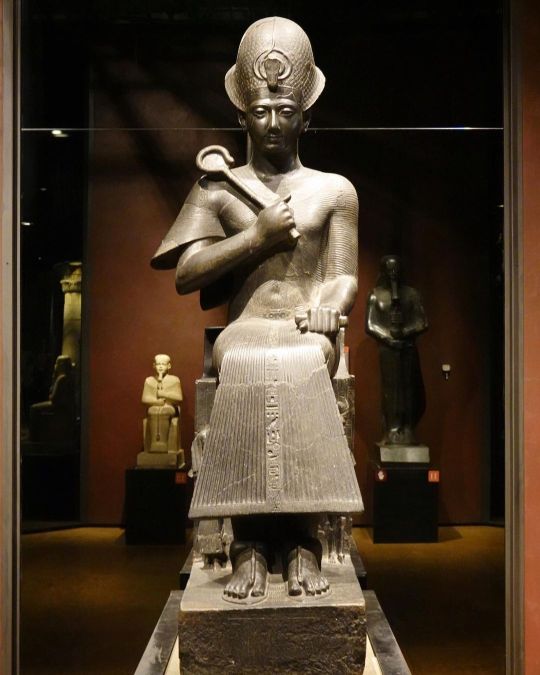
Granodiorite Statue of Ramesses II The king 𓇓𓏏𓈖 “nsw” is depicted in all his majesty. He wears the khepresh crown 𓆣𓂋𓈙𓋙 “ḫprš” and holds the heka sceptre 𓋾𓏘𓄿 “ḥq3” against his chest. His transparent pleated ceremonial dress reveals his muscled body 𓄡𓏏𓏤 “ẖ.t”. Under his sandals 𓍿𓃀𓏏𓋸𓋸 “tjbw.ty” he tramples the Nine Bows 𓌔𓏏𓐂 “psḏ.t”, symbols of the enemies 𓐍𓆑𓏏𓏭𓀏 “ḫfty” of Egypt. On the sides of the throne 𓊨𓏏𓉗 “3s.t” is carved the sema-tawy 𓋍, the knotted heraldic plants of Upper and Lower Egypt representing the union of the Two Lands 𓇾𓇾 “t3wy”. Dynastic continuity is expressed by the figures of his wife Nefertari (𓏏𓅐𓄤𓇋𓏏𓂋𓏭𓈘𓏏) “nfr-tı͗-rı͗-mrı͗.t-mwt” ‘Beautiful Companion, Beloved of Mut’ and his son Amunherkhepeshef on either side of his legs. The long reign of Ramesses lI (𓇳𓏤𓄟𓋴𓇓) “rˁ-msi-sw” ‘Him, Born of Ra’ probably witnessed a stylistic evolution of the royal portrait. The statue 𓂙𓏏𓏭𓀾 “ḫnty” probably belongs to the beginning of the reign of Ramesses I. In any case, it can be no later than the first half of the reign, due to the presence of Queen Nefertari, who died in year 30, This statue is one of the symbols of the @museoegizio In a letter that he wrote during his stay in Turin in 1824, Champollion describes with enthusiasm "the beauty and the admirable perfection of this colossal figure (….): for six whole months I have seen it every day, and always I have the impression of seeing it for the first time. The head is divine, the feet and hands are admirable, the body is voluptuous; I call it the Egyptian Apollo of the Belvedere... in short, I am in love with it”. Granodiorite. New Kingdom, 19th Dynasty, reign of Ramesses II (1279-1213 BC) Karnak, temple of Amon Drovetti Collection (1824). 📸 Richard Mortel - Flickr (Thank you) 𓋹𓎬𓋹𓎬𓋹𓎬𓋹𓎬𓋹𓎬𓋹𓎬𓋹𓎬𓋹𓎬𓋹𓎬𓋹𓎬𓋹𓎬𓋹𓎬𓋹𓎬𓋹𓎬 @egyptologylessons 𓋹𓊽𓋴𓆖𓎛𓇳𓎛 © 𓊁𓊁𓊁𓊁𓊁𓊁𓊁𓊁𓊁𓊁𓊁𓊁𓊁𓊁𓊁 #Ancientegypt #ägypten #egyptology #egypte #egitto #埃及 #مصر #egipto #이집트 #ramsesiii #egyptianstatue #granodiorite #pharaoh #turinmuseum https://www.instagram.com/p/CpilESKuK63/?igshid=NGJjMDIxMWI=
#ancientegypt#ägypten#egyptology#egypte#egitto#埃及#مصر#egipto#이집트#ramsesiii#egyptianstatue#granodiorite#pharaoh#turinmuseum
35 notes
·
View notes
Photo

Several Egyptians on and near a partially buried statue of Ramses II, an ancient Egyptian king from the 19th Dynasty (1850-1860 AD). The statue can currently be found at the Memphis Museum in Egypt. Website of Photo: Getty.edu 📸 Francis Fritt 𓋹𓎬𓋹𓎬𓋹𓎬𓋹𓎬𓋹𓎬𓋹𓎬𓋹𓎬𓋹𓎬𓋹𓎬𓋹𓎬𓋹𓎬𓋹𓎬𓋹𓎬𓋹𓎬 @egyptologylessons 𓋹𓊽𓋴𓆖𓎛𓇳𓎛 © 𓊁𓊁𓊁𓊁𓊁𓊁𓊁𓊁𓊁𓊁𓊁𓊁𓊁𓊁𓊁 #Ancientegypt #ägypten #egyptology #egypte #egitto #埃及 #مصر #egipto #이집트 ramsesii #memphismuseum #memphis #colossalstatue #pharaoh https://www.instagram.com/p/Cpc7AMIObwt/?igshid=NGJjMDIxMWI=
#ancientegypt#ägypten#egyptology#egypte#egitto#埃及#مصر#egipto#이집트#memphismuseum#memphis#colossalstatue#pharaoh
16 notes
·
View notes
Photo
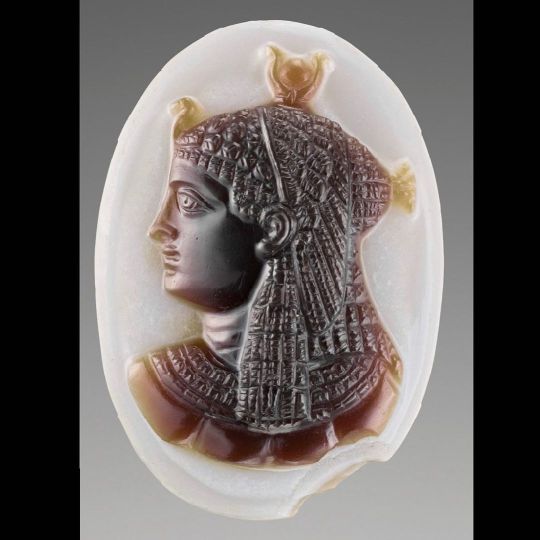
Cameo with Bust of the Goddess Isis with Modern Mount (200-30 B.C.) A cameo gem with a bust of the goddess Aset 𓊨𓏏𓆇 “3s.t” in profile, facing to the left. Isis is shown wearing a vulture headdress, a crown with horns flanking the solar disc, and a broad, striped pectoral; Venus rings are visible on her neck. Her long hair overlaps the pectoral 𓂓𓄿𓂋𓉬 “k3r”and is held in place with a headband. There is damage at the lower right edge of the cameo. Unknown artist/maker 📸 getty.edu 𓋹𓎬𓋹𓎬𓋹𓎬𓋹𓎬𓋹𓎬𓋹𓎬𓋹𓎬𓋹𓎬𓋹𓎬𓋹𓎬𓋹𓎬𓋹𓎬𓋹𓎬𓋹𓎬 @egyptologylessons 𓋹𓊽𓋴𓆖𓎛𓇳𓎛 © 𓊁𓊁𓊁𓊁𓊁𓊁𓊁𓊁𓊁𓊁𓊁𓊁𓊁𓊁𓊁 #Ancientegypt #ägypten #egyptology #egypte #egitto #埃及 #مصر #egipto #이집트 #cameo #aset #egyptiangoddess #jewelry #ancientjewelry https://www.instagram.com/p/CpanvLFO-J-/?igshid=NGJjMDIxMWI=
#ancientegypt#ägypten#egyptology#egypte#egitto#埃及#مصر#egipto#이집트#cameo#aset#egyptiangoddess#jewelry#ancientjewelry
75 notes
·
View notes
Photo
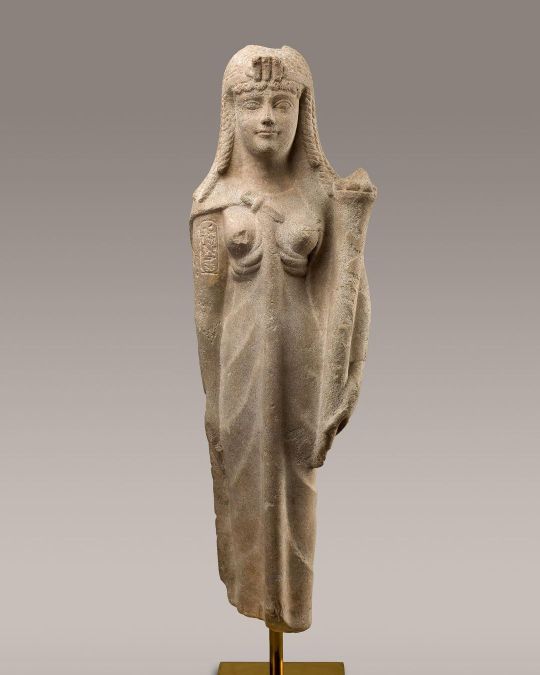
Statue of a Ptolemaic Queen, perhaps Cleopatra VII The statue represents a Ptolemaic queen 𓇓𓈞𓏏 “sw-hm.t” holding a cornucopia. Attributes and dress point to a date in the second or first century B.C., and one recent study notes that details of the queen's hairstyle suggest identification with Cleopatra VII. However, the cartouche actually reading "Cleopatra" (𓈎𓃭𓇋𓍯𓊪𓄿𓂧𓂋𓄿𓏏𓆇 ) “qlı͗op3dra” on this statue's arm would be a highly unusual occurrence, and is, moreover, incorrectly oriented, so that it is probably a modern addition. Period: Ptolemaic Period Dynasty: Ptolemaic Dynasty Date: 200–30 B.C. Geography: From Egypt Medium: Dolomitic limestone Dimensions: H. 62.5 × W. 22 × D. 15 cm, 23 kg (24 5/8 × 8 11/16 × 5 7/8 in., 50.6 lb.) 📸 @metmuseum and description 𓋹𓎬𓋹𓎬𓋹𓎬𓋹𓎬𓋹𓎬𓋹𓎬𓋹𓎬𓋹𓎬𓋹𓎬𓋹𓎬𓋹𓎬𓋹𓎬𓋹𓎬𓋹𓎬𓋹𓎬𓋹𓎬 @egyptologylessons 𓋹𓊽𓋴𓆖𓎛𓇳𓎛 © 𓊁𓊁𓊁𓊁𓊁𓊁𓊁𓊁𓊁𓊁𓊁𓊁𓊁𓊁𓊁𓊁𓊁 #Ancientegypt #ägypten #egyptology #egypte #egitto #埃及 #مصر #egipto #이집트 #cleopatra #metropolitanmuseumofart #statue #greekqueen #pharaoh (at The Metropolitan Museum of Art, New York) https://www.instagram.com/p/Copo-RyuVyi/?igshid=NGJjMDIxMWI=
#ancientegypt#ägypten#egyptology#egypte#egitto#埃及#مصر#egipto#이집트#cleopatra#metropolitanmuseumofart#statue#greekqueen#pharaoh
44 notes
·
View notes
Photo
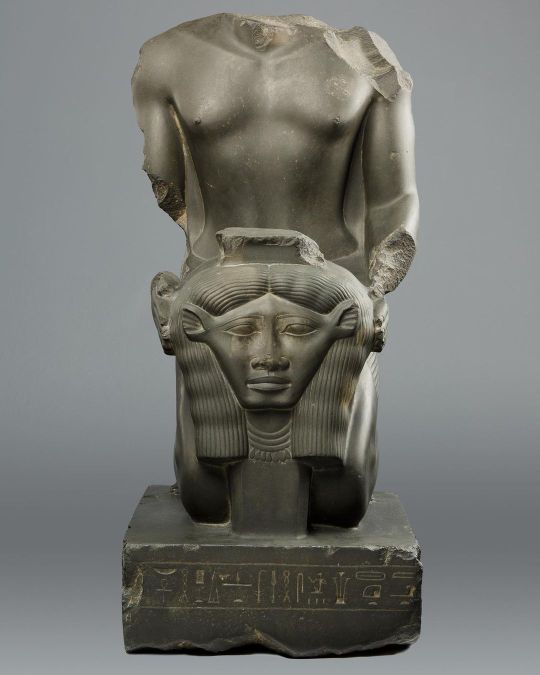
Kneeling statue of Amenemopetemhat Amenemope-em-hat 𓇋𓏠𓈖𓊒𓏏𓅓𓄂𓏏𓏤𓀼 “ı͗mn-mp-m-ḥ3.t” was director of the Singers of the North 𓎕𓏏𓏭𓈇 “mḥty” and Overseer 𓄓𓏤 or 𓅓𓂋 “mr” of the Singers 𓎛𓎿𓋴𓀁𓁐 “ḥsy” of Amenemope. The second title was inherited from his father 𓇋𓏏𓆑 “it”, whose equally fine statue 𓂙𓏏𓏭𓀾 “ḫnty” has recently been discovered at Tanis 𓆓𓂝𓈖𓏏𓊖 “ḏˁn.t”, where there was a cult of Amenemope, a form of the god Amun. The first title implies wider authority. Amenemope-em-hat holds before him the cult object of the cow-eared goddess Hathor 𓉡 “ḥw.t-ḥr” ‘The Temple of Horus’. The proportions of this figure, its muscularity, and such details as the slanted ridges of the collarbone and the shallow depression down the center of the torso represent a conscious attempt in the Late Period to emulate the classic works of the Old and Middle Kingdoms. Period: Late Period, Saite Dynasty: Dynasty 26 Reign: reign of Psamtik I Date: 664–610 B.C. Geography: From Egypt; Said to be from Memphite Region, Memphis (Mit Rahina), Ptah Temple Medium: Meta-Greywacke Dimensions: H. 64.5 × W. 32 × D. 40.5 cm, 101.6 kg (25 3/8 × 12 5/8 × 15 15/16 in., 224 lb.) 📸 @metmuseum and description 𓋹𓎬𓋹𓎬𓋹𓎬𓋹𓎬𓋹𓎬𓋹𓎬𓋹𓎬𓋹𓎬𓋹𓎬𓋹𓎬𓋹𓎬𓋹𓎬𓋹𓎬𓋹𓎬𓋹𓎬𓋹𓎬 @egyptologylessons 𓋹𓊽𓋴𓆖𓎛𓇳𓎛 © 𓊁𓊁𓊁𓊁𓊁𓊁𓊁𓊁𓊁𓊁𓊁𓊁𓊁𓊁𓊁𓊁𓊁 #Ancientegypt #ägypten #egyptology #egypte #egitto #埃及 #مصر #egipto #이집트 #egyptianstatue #saite #lateperiod #egyptianhistory #singer #meteopolitanmuseumofart (at The Metropolitan Museum of Art, New York) https://www.instagram.com/p/Coh6QEIuiwG/?igshid=NGJjMDIxMWI=
#ancientegypt#ägypten#egyptology#egypte#egitto#埃及#مصر#egipto#이집트#egyptianstatue#saite#lateperiod#egyptianhistory#singer#meteopolitanmuseumofart
42 notes
·
View notes
Photo
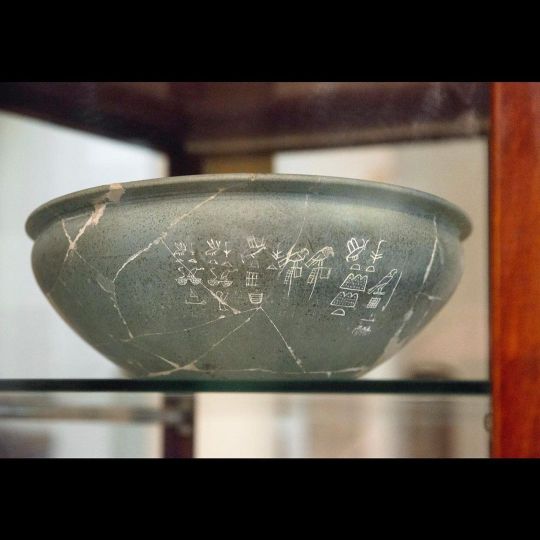
Stone Vessel with 1st Dynasty Pharaonic Names Inscription: (right to left) 1. Djer 𓅃𓊂 𓈖𓋞 2. Den 𓆥 𓈊𓈊𓏏 𓈢𓈢 3. Adjib 𓆥 𓊪𓈟 4. Semerkhet 𓆥𓅒𓀛 5. Qaa 𓆥 𓏘𓂝 📸 kairoinfo4u - Flickr 𓋹𓎬𓋹𓎬𓋹𓎬𓋹𓎬𓋹𓎬𓋹𓎬𓋹𓎬𓋹𓎬𓋹𓎬𓋹𓎬𓋹𓎬𓋹𓎬𓋹𓎬𓋹𓎬𓋹𓎬𓋹𓎬 @egyptologylessons 𓋹𓊽𓋴𓆖𓎛𓇳𓎛 © 𓊁𓊁𓊁𓊁𓊁𓊁𓊁𓊁𓊁𓊁𓊁𓊁𓊁𓊁𓊁𓊁𓊁 #Ancientegypt #ägypten #egyptology #egypte #egitto #埃及 #مصر #egipto #이집트 #vessel #cairomuseum #pharaoh (at Cairo Museum) https://www.instagram.com/p/CoaEgU0uey-/?igshid=NGJjMDIxMWI=
15 notes
·
View notes
Photo

Sneferu’s Tablet and Dinner Ware with Pharaonic Titles and Names Sneferu is considered the pharaoh who began the 4th dynasty (2613-2589 BC), who reigned for 24 years. He built at least three pyramids (Bent, Meidum, and Red Pyramid) that survive to this day and introduced major innovations in the design and construction of pyramids. Inscription 📸 1: (top - right to left) 𓆥𓅒𓎟𓌶𓏏𓅉𓋴𓄤𓆑𓂋𓅱 “nsw.t bity, nbty, nb m3ˁt, bı͗k nbw, s-nfr.w” ‘King of Upper and Lower Egypt, The Two Ladies, Lord of Maat, The Golden Horus, Sneferu’. (bottom right - vertical) 𓅃𓊂𓎟𓌶𓏏 “hrw srḫ nb m3ˁt” ‘Horus Serekh (Name) Lord of Maat’ (bottom right - horizontal) (𓋴𓄤𓆑𓂋𓅱) 𓏙𓌀𓊽𓋹 “s-nfr.w, dı͗ w3s ḏd ˁnḫ” ‘The one who has been made perfect, Given power, stability, and life’. Inscription 📸 2-3: 𓅃𓊂𓎟𓌶𓏏 “hrw srḫ nb m3ˁt” ‘Horus Serekh (Name) Lord of Maat’. 📸 kairoinfo4u - Flickr 𓋹𓎬𓋹𓎬𓋹𓎬𓋹𓎬𓋹𓎬𓋹𓎬𓋹𓎬𓋹𓎬𓋹𓎬𓋹𓎬𓋹𓎬𓋹𓎬𓋹𓎬𓋹𓎬𓋹𓎬𓋹𓎬 @egyptologylessons 𓋹𓊽𓋴𓆖𓎛𓇳𓎛 © 𓊁𓊁𓊁𓊁𓊁𓊁𓊁𓊁𓊁𓊁𓊁𓊁𓊁𓊁𓊁𓊁𓊁 #Ancientegypt #ägypten #egyptology #egypte #egitto #埃及 #مصر #egipto #이집트 #sneferu #pharaoh #egyptianartifacts #cairomuseum (at Cairo Museum) https://www.instagram.com/p/CoXe_17ONVo/?igshid=NGJjMDIxMWI=
#ancientegypt#ägypten#egyptology#egypte#egitto#埃及#مصر#egipto#이집트#sneferu#pharaoh#egyptianartifacts#cairomuseum
24 notes
·
View notes
Photo

Making Offering to Amun-Ra - Rock Inscription at Wadi Hammamat Pharaoh Seti I (1290–1279 BC), 19th Dynasty, is making a offering of papyrus 𓇅𓏤𓆰 “w3ḏ” plants to the state god 𓊹 “nṯr” Amun-Ra. The god is identified by his hieroglyphic title and his double plumed 𓋛 crown. Inscription: Seti I (𓊪𓏏𓎛𓁣𓇌𓌸𓈖) “stḥy mri.n-ptḥ” ‘Seti, Beloved of Ptah’ Menmaatre (𓇳𓏠𓁦) “mn-m3ˁt-rˁ” ‘Enduring is the Maat of Ra’ Amun-Ra 𓇋𓏠𓈖𓇳𓏤𓎟𓇯𓋾𓋆 “ı͗mn-rˁ nb pt ḥk3 w3s.t” ‘Amun-Ra, Lord of the Sky and Ruler of Thebes’ Wadi Hammamat is a dry river bed in Egypt's Eastern 𓋁𓃀𓏏𓏭𓈊 “3bty” Desert 𓅱𓂝𓂋𓏏𓈊 “wˁr.t”, about halfway between Al-Qusayr and Qena. It was a major mining region and trade route east from the Nile Valley in ancient times, and three-thousand-years 𓆳𓊪𓏏𓏤𓆾 “rnp.wt 3000” of rock carvings and graffiti make it a major scientific and tourist site today. The wadi contains many carvings and inscriptions dating from before the earliest Egyptian Dynasties to the modern era, including the only painted petroglyph known from the Eastern Desert and drawings of Egyptian 𓂋𓐝𓎀𓀂𓀭𓏪 “rmṯ” reed boats dated to 4000 BCE. 📸 kairoinfo4u - Flickr 𓋹𓎬𓋹𓎬𓋹𓎬𓋹𓎬𓋹𓎬𓋹𓎬𓋹𓎬𓋹𓎬𓋹𓎬𓋹𓎬𓋹𓎬𓋹𓎬𓋹𓎬𓋹𓎬𓋹𓎬𓋹𓎬 @egyptologylessons 𓋹𓊽𓋴𓆖𓎛𓇳𓎛 © 𓊁𓊁𓊁𓊁𓊁𓊁𓊁𓊁𓊁𓊁𓊁𓊁𓊁𓊁𓊁𓊁𓊁 #Ancientegypt #ägypten #egyptology #egypte #egitto #埃及 #مصر #egipto #이집트 #wadihammamat #rockcarving #setii #amun #seti #amunra (at Wadi Hammamat) https://www.instagram.com/p/CoINAbSu5LU/?igshid=NGJjMDIxMWI=
#ancientegypt#ägypten#egyptology#egypte#egitto#埃及#مصر#egipto#이집트#wadihammamat#rockcarving#setii#amun#seti#amunra
49 notes
·
View notes
Photo
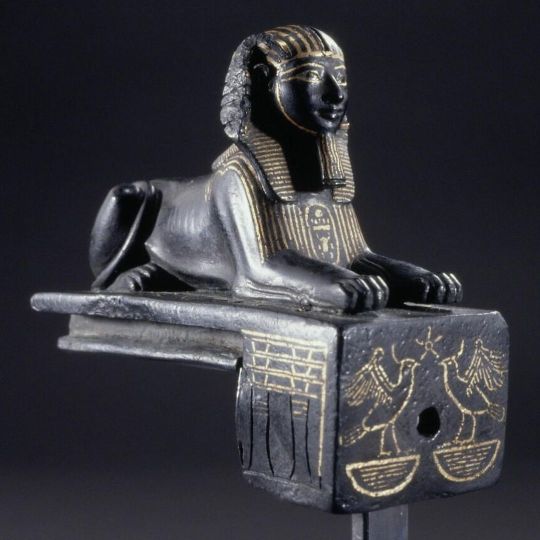
Sphinx Furniture Part of Thutmoses III The object belonging to an unknown furniture, has the carved image of a reclining sphinx 𓎛𓅱𓃭𓏤 “ḥw” or 𓊏𓊪𓃭 “šsp” with the throne name of the pharaoh in a cartouche Menkheperre (𓇳𓏠𓆣) “mn-ḫpr-rˁ” ‘Lasting is the Manifestation of Ra’. The sphinx sits a top of the symbol of the Nine Bows 𓌔𓏏𓐂 “psḏ.t” (traditional enemies of Egypt). On each side is flanked by two 𓊽𓊽 djed pillars ‘stability’ and at the front are two rehyt birds 𓂋𓐍𓇌𓏏𓅛𓀀𓁐𓏫 “rh.yt” (representing the common people of Egypt) standing on two 𓎟 Neb baskets “all” represented by the star 𓇼 “sb3”, indicating the word worship 𓇼𓄿𓀃 “dw3”. Expression: “All 𓎟 the people 𓅛 worship 𓇼 the pharaoh Menkheperre (𓇳𓏠𓆣)” Thutmose III (1479-1425 BC) (𓅝𓄟𓊃𓄤𓆣𓏫) “ḏḥwty-ms-nfr-ḫprw” ‘Thutmoses (Born of Thoth), Beautiful of Manifestations’ was the sixth 𓏿 pharaoh 𓉐𓉼 “pr-ˁ3” ‘Great House’ of the Eighteenth Dynasty. Officially, Thutmose III ruled Egypt/Kemet 𓆎𓅓𓏏𓊖 “kmt” for almost 54 𓎊𓏽 years 𓆳𓊪𓏏𓏤𓏪 “rnp.wt”. Dimensions Height : 7.8 cm ; Width : 8.85 cm ; Depth : 3.85 cm Materials Bronze & gold 📸 @museelouvre 𓋹𓎬𓋹𓎬𓋹𓎬𓋹𓎬𓋹𓎬𓋹𓎬𓋹𓎬𓋹𓎬𓋹𓎬𓋹𓎬𓋹𓎬𓋹𓎬𓋹𓎬𓋹𓎬𓋹𓎬𓋹𓎬 @egyptologylessons 𓋹𓊽𓋴𓆖𓎛𓇳𓎛 © 𓊁𓊁𓊁𓊁𓊁𓊁𓊁𓊁𓊁𓊁𓊁𓊁𓊁𓊁𓊁𓊁𓊁 #Ancientegypt #ägypten #egyptology #egypte #egitto #埃及 #مصر #egipto #이집트 #furniture #thutmosesiii #sphinx #pharaoh (at Louvre Museum Paris) https://www.instagram.com/p/CoAm2Q7uz2d/?igshid=NGJjMDIxMWI=
#ancientegypt#ägypten#egyptology#egypte#egitto#埃及#مصر#egipto#이집트#furniture#thutmosesiii#sphinx#pharaoh
39 notes
·
View notes
Photo

Cylinder Wax Seal of Montuhotep II - 11th Dynasty (2033-1982 BC) Mentuhotep II (Ancient Egyptian: (𓏠𓈖𓍿𓅱𓏛𓏏𓊪) “mntw-ḥtp” ‘Mentu is satisfied’), also known under his prenomen Nebhepetre (Ancient Egyptian: (𓇳𓎟𓊤) nb-ḥpt-rˁ, meaning ‘The Lord of the rudder of Ra’), was an ancient Egyptian pharaoh 𓉐𓉼 “pr-ˁ3” ‘Great House’, the sixth 𓏿 “sisw” ruler 𓋾𓏘𓄿𓀭 “ḥq3” of the Eleventh Dynasty. He is credited with reuniting Egypt/Kemet 𓆎𓅓𓏏𓊖 “kmt”, thus ending the turbulent First Intermediate Period and becoming the first pharaoh of the Middle Kingdom. He reigned for 51-years 𓆳𓊪𓏏𓏤𓎊𓏺, according to the Turin King List. Mentuhotep II succeeded his father Intef III 𓏎𓈖𓏏𓆑) “ı͗nı͗-ı͗t.f” ‘The one whom his father has brought forth’ on the throne 𓊨𓏏𓉗 “3s.t” and was in turn succeeded by his son 𓅭 “s3” Mentuhotep III. Description: The seal is engraved from electrum (gold-silver natural mix) and contains the Horus Name of the pharaoh 𓅃𓊂𓄥𓈃𓇳𓎟𓊤 “sm3-t3wy nb-ḥpt-rˁ” ‘The Uniter of the Two Lands, The Lord of the Rudder of Ra’. The name is surrounded by protective striking cobras. Dimensions Length: 7.45 cm, Diameter : 1.75 cm Material and Technique Electrum seal Silver wire support Technique : Engraving 📸 @museelouvre 𓋹𓎬𓋹𓎬𓋹𓎬𓋹𓎬𓋹𓎬𓋹𓎬𓋹𓎬𓋹𓎬𓋹𓎬𓋹𓎬𓋹𓎬𓋹𓎬𓋹𓎬𓋹𓎬𓋹𓎬𓋹𓎬 @egyptologylessons 𓋹𓊽𓋴𓆖𓎛𓇳𓎛 © 𓊁𓊁𓊁𓊁𓊁𓊁𓊁𓊁𓊁𓊁𓊁𓊁𓊁𓊁𓊁𓊁𓊁 #Ancientegypt #ägypten #egyptology #egypte #egitto #埃及 #مصر #egipto #이집트 #waxseal #cylinderseal #montuhotepii #pharaoh #cobra #engraving #horusname #louvremuseum (at Louvre Museum Paris) https://www.instagram.com/p/Cn9v3DwO509/?igshid=NGJjMDIxMWI=
#ancientegypt#ägypten#egyptology#egypte#egitto#埃及#مصر#egipto#이집트#waxseal#cylinderseal#montuhotepii#pharaoh#cobra#engraving#horusname#louvremuseum
21 notes
·
View notes